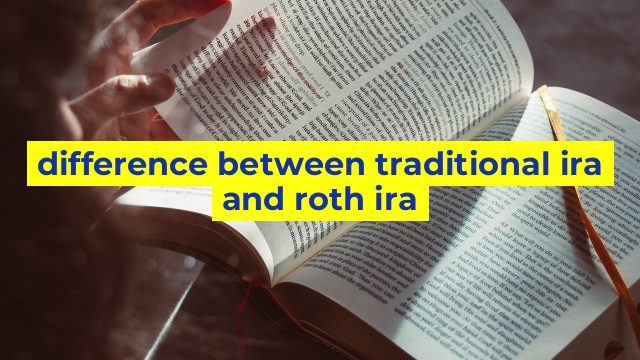Difference Between Traditional IRA and Roth IRA
Introduction
Individual Retirement Accounts (IRAs) are a popular tool to save money for retirement. Both Traditional and Roth IRAs offer significant tax advantages, but they differ in many ways. It is vital to understand how these accounts function in order to determine which one is a better fit for your financial needs. In this article, we will explore the differences between Traditional IRAs and Roth IRAs.
Contributions
One significant difference between the two types of IRAs is how contributions are taxed. Traditional IRA contributions are made on a pre-tax basis, which means they reduce your taxable income. The tax deduction for these contributions can be claimed on your tax return, and taxes are deferred until you withdraw funds in retirement. On the other hand, Roth IRA contributions are made on an after-tax basis, which means they do not reduce your taxable income. However, withdrawals in retirement are tax-free.
Taxation
Another significant difference between Traditional and Roth IRAs is how they are taxed. With Traditional IRAs, you don’t pay taxes on contributions, and your investments grow tax-deferred until you withdraw them in retirement. However, the money you withdraw from your Traditional IRA is subject to income taxes. With Roth IRAs, your contributions are taxed upfront, so you can withdraw your funds tax-free once you reach retirement age. The money you withdraw from your Roth IRA is not subject to income taxes or capital gains taxes.
Withdrawals
Withdrawals from IRAs also differ based on the type of account. Traditional IRA withdrawals are subject to income tax, and if you make withdrawals before age 59 1/2, you may also be subject to a 10% early withdrawal penalty fee. Roth IRAs, on the other hand, offer more flexibility. You can withdraw your contributions from your Roth IRA at any time without facing taxes or penalties. However, you may be subject to penalties and taxes if you withdraw your investment earnings before age 59 1/2.
Conversion
One interesting aspect of IRAs is that you can convert Traditional IRA money to a Roth IRA. However, there are tax implications to this conversion. When you convert funds from a Traditional IRA to a Roth IRA, you must pay taxes on the amount of money you convert. This could be a significant amount of taxes, so it’s essential to plan accordingly to determine whether a conversion makes sense for you.
Conclusion
In summary, Traditional and Roth IRAs offer different tax advantages and rules. Traditional IRAs offer immediate tax deductions and tax-deferred growth but are subject to taxes when you withdraw your funds in retirement. Roth IRAs, on the other hand, don’t offer an immediate tax deduction, but contributions can grow tax-free, and withdrawals in retirement are tax-free. Ultimately, the decision to choose a Traditional or Roth IRA depends on your unique financial situation and retirement goals. Consulting with a financial advisor can help you make the best choice for your future.
Table difference between traditional ira and roth ira
| Traditional IRA | Roth IRA | |
|---|---|---|
| Tax Deductible Contributions | Yes | No |
| Taxable Distributions | Yes | No (if rules are followed) |
| Early Withdrawal Penalty | Yes (if withdrawn before age 59.5) | Yes (if withdrawn before age 59.5 and no exceptions apply) |
| Income Limits | No (but may affect tax deductibility) | Yes |
| Required Minimum Distributions | Yes (starting at age 72) | No (owner can leave funds in account for as long as they want) |

